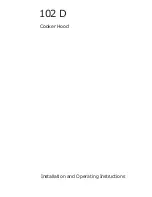
8
3. An insulated control panel powered by low-voltage electricity (12 V DC) guarantees the safety of the lighting system.
4. The cooker hood is very efficient in capturing dirt particles in the air thanks to the special construction of the air duct
and the shape of the oil catcher.
5. The cooker hood is powered by household electricity at 220/240 V, 50 Hz.
5
. BEFORE INSTALLING
1. Make sure the room is clean before installing the cooker hood. Avoid the suction of wood chips and dust.
2. The cooker hood must not share the same ventilation pipe with other devices, e.g., gas ovens, heating furnaces or
hot-air ovens.
3. The angle of the bend of the ventilation pipe should not be less that 120º; the pipe should run horizontally or,
alternatively, rise vertically from its start and then run towards an external wall.
4. After installing the cooker hood, make sure that it is horizontal. This will prevent the grease from gathering at one end.
6
. INSTALLATION INSTRUCTIONS
Before installing the cooker hood you must decide whether you want to use it as an extractor hood or as a filter hood (for
recirculation).
What’s the difference between extraction and recirculation?
In order to get the best performance from your cooker, air is removed from the room through an exhaust duct that leads
outdoors. Unfortunately, if you live in a flat or if the hood is too far from an external wall, that may not be possible. In this
case the only alternative is to recirculate the air.
In recirculation mode stale air is sucked in through the grease filter and passed through an active-carbon filter for
purification, after which the purified air is returned to the room via an opening in the hood.
What is a carbon filter and do I need one?
All cooker hoods come with a grease filter, but if the hood is used for recirculation (filter hood) an active-carbon filter is
required in addition to the grease filter.
Right
Wrong
Wrong
Summary of Contents for GHB970IX
Page 1: ......
Page 11: ...10 Fig 3 Fig 4 Fig 5 ...
Page 34: ...11 Fig 2 Rear view of the cooker hood ...
Page 35: ...12 Fig 3 Fig 4 Fig 5 Fig 6 ...
Page 40: ...17 Fig 5 Fig 6 Fig 7 Fig 8 Fig 9 ...
Page 58: ...11 Fig 2 Rear view of the cooker hood ...
Page 59: ...12 Fig 3 Fig 4 Fig 5 Fig 6 ...
Page 82: ...11 Fig 2 Rear view of the cooker hood ...
Page 83: ...12 Fig 3 Fig 4 Fig 5 Fig 6 ...
Page 95: ......










































